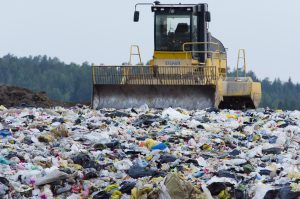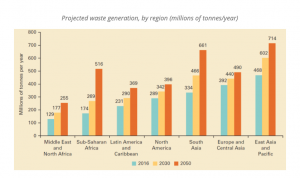In this blog, Dr Semra Bakkaloglu, a research associate at the Sustainable Gas Institute (SGI) for the Methane and Environment Programme, examines how and why the waste sector needs to be overhauled to achieve net zero emissions.

With the COP26 less than three months away, countries are invited to come up with ambitious 2030 emission reduction targets that match the mid-century net zero. The public have also demonstrated their support for sustainability and expressed a desire for immediate action. However, net zero is not possible unless the waste sector is overhauled.
Waste is a global issue. Municipal solid waste generation has increased significantly in recent decades as a result of population growth and urbanisation. The World Bank expects global waste to increase to 70% by 2050 from that generated in 2018. The 1.6 billion tonnes of CO2-eq emissions estimated for 2016 is projected to rise to 2.6 billion tonnes by 2050 (Kaza et al., 2018). Emissions from the waste sector account for about 5% of global greenhouse gas (GHG) emissions (World Bank, 2018). Emissions are primarily caused by disposal in open dumps and landfills without landfill gas collection systems.

Methane, which is produced by the decomposition of organic waste, is the largest contributor of GHG emission in the waste sector. It is 28-34 times more potent than CO2 over a 100-year period (Etminan et al., 2016). Endeavours to formalise the waste management can cut GHG emissions substantially. Although the waste sector had a major relative reduction in GHG emissions of 20% over the other sectors between 1990 and 2015 (UNFCC, 2015) due to a number of factors, including improved landfill standards, increase in landfill gas recovery being used for energy, changes in waste type sent to landfill and decrease in food waste amount, further mitigation of remaining emissions is getting tougher.
Waste management strategies have changed recently. With the UK government commitment to achieving “Net-Zero” emissions by 2050, all biodegradable waste will be eliminated from landfill by 2025, with food waste separated from inorganic waste collections (CCC, 2019). Additionally, EU waste legislation will require separate biodegradable collection by 2024, as well as a new target of no more than 10% waste landfilling by 2035 (EU methane strategy, 2020). These rapid changes in the composition of new waste inputs to landfills are changing the landfill gas production rate and composition (Bakkaloglu et al., 2021a). However, in a recent study we demonstrated that biogas plant could be a significant source of methane emissions. Diverting biodegradable waste to anaerobic and composting plants can help reduce landfill emissions and provide sustainable energy, but it may also contribute significantly to methane emissions from biogas plants unless necessary mitigation measures are implemented.
What actions need to take?
Further reduction of emissions from waste sector requires systematic approach, following:
• Cutting down on food waste
• More incentives for the collection and usage of organic wastes or residuals from farming
• More emission measurements on composting and biogas facilities
• Monitoring of biogas plant emissions on a daily basis
• Improvement of leaks caused by poor biogas plant design or maintenance
• Capturing of landfill emissions by effective gas recovery system and topsoil cover materials
• Minimizing the uncertainties in measured emission caused by methodological and meteorological conditions
• Revising the default landfill oxidation values for closed and active landfill sites to improve emission inventories
• Better regulations for monitoring measurements, reporting of emissions by companies and verification of emissions
In order to assess waste management strategies, more research is needed to estimate emissions from the biomethane supply chain and composting facilities, as well as monitor landfill emissions over time.
We can employ our resources, such as food waste, sludge, garbage and even wilted autumn leaves to generate sustainable energy for a decarbonised future. However, further research on waste to biomethane technologies, as well as reliable monitoring and reporting methodologies are essential to achieve net zero goal.
References:
Bakkaloglu, S., Lowry, D., Fisher, R.E., France, J.L., and Nisbet, E.G.. 2021a, Carbon isotopic characterisation and oxidation of UK landfill methane emissions by atmospheric measurements. Waste Management.
https://doi.org/10.1016/j.wasman.2021.07.012
Bakkaloglu, S., Lowry, D., Fisher, R.E., France, J.L., Brunner, D., Chen, H. and Nisbet, E.G., 2021b. Quantification of methane emissions from UK biogas plants. Waste Management, 124, pp.82-93. https://www.sciencedirect.com/science/article/pii/S0956053X21003809
Etminan, M., Myhre, G., Highwood, E. & Shine, K. Radiative forcing of carbon dioxide, methane, and nitrous oxide: A significant revision of the methane radiative forcing. 2016. Geophysical Research Letters 43, 12,614-612,623.
EU Methane Strategy, 2020. Web page https://ec.europa.eu/energy/topics/oil-gas-and-coal/methane-emissions_en#eu-methane-strategy-, accessed on 29 July, 2021.
Kaza, Silpa; Yao, Lisa C.; Bhada-Tata, Perinaz; Van Woerden, Frank. 2018. What a Waste 2.0 : A Global Snapshot of Solid Waste Management to 2050. Urban Development;. Washington, DC: World Bank. © World Bank. https://openknowledge.worldbank.org/handle/10986/30317 License: CC BY 3.0 IGO.
Word Bank, 2018. Trends in Solid waste management. Web page : ttps://datatopics.worldbank.org/what-a-waste/trends_in_solid_waste_management.html accessed on 29, July 2021.
UNFCCC. 2017. “National Greenhouse Gas Inventory Data for the Period 1990–2015.” United Nations Framework Convention on Climate Change. http://unfccc.int/resource/docs/2017/sbi/eng/18.pdf.